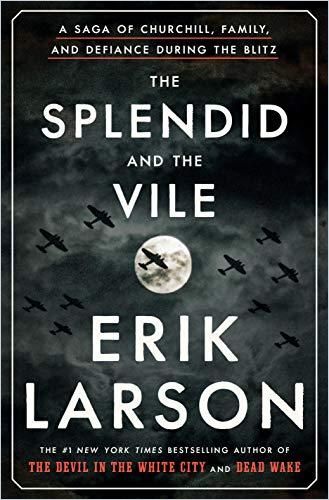Eric Larson’s intimate retelling of the Battle of Britain brings the nation’s rulers, aristocrats and ordinary citizens to vivid life.

Intimate Retelling of History
Bestselling author Erik Larson specializes in tales of individuals living through 20th century history. If he’s not depicting a diplomatic family in Berlin during Hitler’s rise – In the Garden of Beasts – he sets the inventor of the “wireless,” Guglielmo Marconi, against an ocean-wide manhunt for a murderer in Thunderstruck. Or he evokes history through multiple intensely researched portraits, as in Dead Wake – his depiction of the sinking of the Lusitania in World War I. Larson writes with great narrative drive, as in The Devil in the White City.
He uses social interactions – not recitations of facts – to bring to life the idiosyncrasies of each age, like the depiction of life in Galveston in 1900 in Isaac’s Storm. At times, the author seems at a disadvantage here because Winston Churchill’s story is well-known, but Larson’s sense of telling detail makes this a fascinating read.
Britain’s Survival at Risk
Larson understands that towering figures like Churchill, Adolf Hitler and Franklin D. Roosevelt make history, while millions of ordinary citizens must contend with their leaders’ choices. Britain declared war on Germany on September 3, 1939. Few in power, Larson notes, including England’s king, had confidence in Winston Churchill, but Parliament chose him.
Larson shows that Churchill knew he had to instill confidence in his people and convince the United States that Britain would never capitulate. Churchill believed that only American participation could help Britain win the war. Larson writes with compassion about how Churchill suffered depression, and yet he rallied the British heroically.
Churchill the Strategist
Larson explains that Churchill understood that Britain had to win in the air, and he makes it clear this was an advanced viewpoint for his era. Fortunately for the British, the head of the Luftwaffe, Herman Göring, convinced Hitler that his air force could bring Britain to heel. Larson, like many historians, takes cynical amusement in Göring’s hubris. Larson finds the essence of Churchill’s determination in his famous, stirring speech: “We shall fight…on the seas and oceans…in the fields and in the streets…we shall never surrender.”
Cigars and Brandy
Larson never glosses over Britain’s class divides, which profoundly affected each person’s wartime experience. Larson makes it clear how well Churchill lived, but the author’s sense of irony is too acute to belabor the point. He lets readers draw their own opinions. Churchill spent most weekends at Chequers, his estate outside London, meeting with generals and ministers and spending time with his family.
By July, German bombing attacks came daily. Larson depicts the morale-boosting sport of watching airplane dog fights from rooftops or listening to radio hosts do play-by-plays of the attacks. As throughout, Larson places the reader in this time and place – his ability to do so is one of his great gifts.
Decadent Life in London
Larson wields gossip like a searchlight to reveal day to day life. He describes parties, politics and love affairs as planes danced in combat overhead. At times, Larson’s gossip turns out to be more memorable than his rendering of battles. But he does not flinch from the destruction.
The odds that any one person would die on any night were slim, but the odds that someone, somewhere in London would die were 100%.Erik Larson
In public bomb shelters, beds were stacked three high next to filthy latrines. But, Larson reminds readers, Churchill’s family, friends and aides never ran out of champagne, brandy, vintage wine, fine food or cigars at Chequers. The London elite stayed in the luxurious rooms and posh bomb shelter of the Dorchester Hotel. The author revels in telling how young women slept with multiple partners. Married men and women had blatant affairs. No one wanted to be alone.
Hopkins Links the US and the UK
Larson depicts the drama of the RAF replenishing its fighters faster than it lost them. British morale grew, as did Churchill’s. Hitler’s focus shifted to Russia. Roosevelt won re-election to a third term. Germany and Britain celebrated Christmas 1940 without bombings.
“This island needs our help now, Mr. President, with everything we can give them.”Harry Hopkins
At Chequers, the Churchill family enjoyed a festive holiday. FDR dispatched his advisor Harry Hopkins to London, where Churchill and the British charmed him. He urged Roosevelt to join the war. Larson paints Hopkins’s visit as cementing a pivotal bond between the United States and the United Kingdom.
Nightlight Amid the Bombs
Larson savors London’s wartime nightlife. Young people, including Churchill’s daughter Mary, dined and danced at London’s clubs. In March 1941, a German bomb demolished the chic Café de Paris. Larson offers the scene of Mary and her party, who, arriving after the bombing, went elsewhere to dance until 6:30 a.m. Larson presents this as courage under fire, but it seems more like repulsive noblese oblige.
Larson’s easy shifts from the broad strokes of the war to detailed human portraits sustain his informative and entertaining history. For instance, he joins Churchill’s son Randolph aboard the Navy ship Glenroy, where racked up gambling losses he could not pay – $190,000 in today’s dollars. His pregnant wife Pamela moved to London to find work – something unthinkable, Larson reveals, for a woman in her social position at that time. Larson admires her pragmatism, as he recounts how Pamela checked into the Dorchester and sold her jewelry, including a wedding gift of diamond earrings. In March 1941, Averell Harriman arrived as FDR’s special ambassador. Harriman checked into the Dorchester and – as Larson foreshadows their romance – befriended Pamela Churchill. In another memorable scene, he depicts Harriman joining Winston Churchill on the roof of 10 Downing Street to watch RAF air fights as German bombers killed hundreds night after night.
Pearl Harbor
Overall, 44,652 citizens died, including 5,626 children, and 52,370 were injured. On April 16, 1941, alone, almost 1,200 Londoners were killed. As bombs shook the Dorchester that day, Larson pauses with some glee to describe Harriman and Pamela Churchill becoming lovers, capturing a human element amid the destruction. The ambassador later wed Churchill’s daughter-in-law, but that’s another story.
Larson also depicts one of the war’s most inexplicable moments: on the night of May 10, deputy führer Rudolf Hess parachuted into Scotland, thinking he could broker peace. Larson marvels at Hess’s descent from the sky into the rural hills, where astonished local police took him into custody.
It would be foolish to disguise the gravity of the hour. It would be still more foolish to lose heart and courage.”Winston Churchill
Then, on December 7, 1941, as Winston Churchill listened with Harriman, the BBC announced Japan’s raid on Pearl Harbor. Larson paints Churchill as ebullient at the blistering attack on the United States. He knew this meant America would join the war.
Erik Larson evokes the macro and the micro of the Battle of Britain. He applies the same macro and micro approach to military strategy and its impact on people’s lives. It’s quite a balancing act, but Larson never falters.





